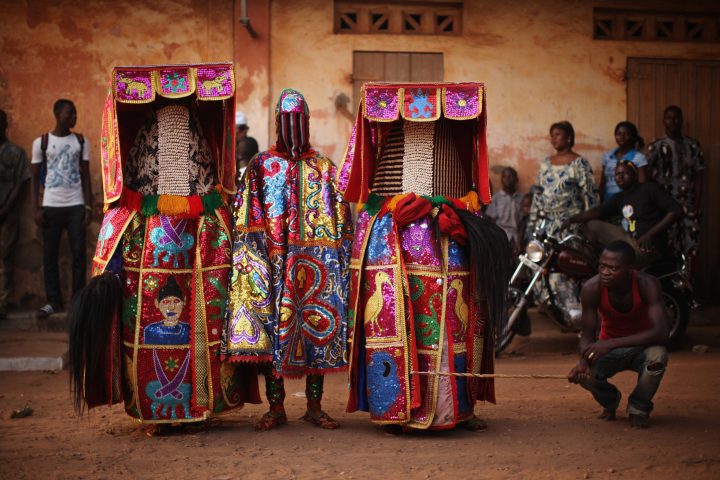CULTURE
Africa’s religious traditions: In praise of the ancestors

Animism and its veneration of the ‘dear departed’ have a human scale absent from the ‘great’ faiths. Drew Forrest makes the case for Africa’s religious traditions.
Those who stayed away when Geoffrey Oryema headlined at Womad in Benoni in 2000 – the poor turnout spoke of South Africa’s cultural isolation – missed more than a luminous musical performance.
At the height of his powers the “Orpheus of Acholiland” made a compelling statement about the continent’s religious beliefs.
At the age of 24 Oryema was smuggled out of Uganda in the boot of a car after his father, a cabinet minister, was denounced as a plotter and murdered by Idi Amin. Geoffrey did not return for 39 years.
Hence the persistent note of sorrow in his songs: since Ugandan independence, the Acholi minority he sprang from has been trapped in endless cycles of regional and ethnic violence.
“In this land of Anaka [his father’s ancestral village]… we had dreams of a clear, green land… /Dead sand, dead sand,” he lamented on his first album, Exile.
Central to Oryema’s performance on the Womad night stage were the songs of his magisterial fourth album, Spirit. Released in France the previous year, it revolved around the death of his father, Erinayo…
Late in the evening I walked down
Down by the river
Plunging my hands in the water
I felt the spirit moving
The spirit of my father protects me
Guides me
(“Spirits of my Father”)
… and of his brother, John, who died during Geoffrey’s exile:
I can hear your voice
From a distant place
Among the flowers and grass
I can hear your steps beneath
The stone…
(“Omera John”)
In “Save Me” we meet the same idea: to a repeated, hypnotic motif the song tells of a man who, in a dream or trance, falls under the paralysing thrall of a star. He calls out to the sun and the moon, who come to his aid.
This is animism, the belief, pervasive in Africa, that the cosmos teems with innumerable spirit beings that share human concerns and can be harnessed to the human project.
The result, wrote the originator of the term, anthropologist Edward Burnett Tylor, was a vision of “universal vitality” whereby “sun and stars, trees and rivers, winds and clouds become personal animate creatures”.
“The whole psychic atmosphere of the African village is filled with belief in this magical power,” wrote the father of African theology, Kenya’s John Mbiti, who described Africans as “notoriously religious”.
It is a noble idea, simpler and more dignified than the esoteric contortions of Christian theology and better suited to an age when people are striving for a new relationship with the natural world.

An ‘Egungun’ spirit stands during a Voodoo ceremony on January 11, 2012 in Ouidah, Benin. (Photo by Dan Kitwood/Getty Images)
Animism has no doctrine of the soul’s immortality and no eschatological expectations, such as judgement in the afterlife or the evangelical fantasy of “the Rapture”.
It has no central authority, no set liturgy or creed and no interest in doctrinal compliance – the main source of religious conflict and persecution down the centuries.
It takes many forms specific to different ethnicities, meaning that unlike Christianity and Islam it has no global ambitions and does not try to stuff itself down the throat of unbelievers.
Despite the imposition of the coloniser’s beliefs, it has proved extremely durable. In many parts of Africa and the New World it has fused with Christianity in syncretic hybrids that enshrine the traditional practices of ancestral veneration, ritual purification by water, prophecy, exorcism, healing and the interpretation of dreams.
Victorians like Tylor thought of animist belief in Darwinian terms, as the earliest stage in the evolution of religion and a window on the “primitive mind”. This was a step forward, at least, from the notion of an unbridgeable gulf between the “civilised” and the “savage”.
Later scholars turned against such evolutionary thinking as deeply misconceived. They also rejected the “degradation theory”, according to which animist beliefs are degenerate borrowings from high cultures such as ancient Egypt.
“All contemporary cultures and religions [are] regarded as comparable,” writes anthropologist George Kerlin Park.
Most traditional African religions hold with a single Creator – but in a way that recalls the deism of the European Enlightenment. The widespread belief is that God created the universe, but is so remote that he does not engage with it and cannot be approached directly.
The Oromo of the Horn of Africa, for example, reject the Christian ideas of the God of love, God the Father and the Trinity as implying weakness. According to historian of religion Julian Baldick, their Waqa is the all-powerful demiurge of the great forces of nature, “the sky, the stars, the clouds, the god of thunder and lightning”.
Their proverbs convey the deity’s deafness to human cries and the need for resigned submission among his creatures: “A man does not stop praying and God does not change what he has decided”; “People are right to praise God when someone is killed by lightning”; “One does not understand the deeds of God or the laughter of dogs”.
In a widespread tradition, the Dinka of South Sudan hold that God withdrew from the world when the first woman lifted her pestle to pound millet and struck the vault of the sky.
Kenya’s Kikuyu believe the deity has:
No father, no mother, nor wife
nor children
He is alone
He is neither a child nor
an old man
He is the same today
as he was yesterday
For this reason, worship of the high god is rare in African tradition – it is the multitude of secondary divinities, who throng the sublunary sphere, that are the objects of veneration, propitiation and service. Foremost among them are the ancestors or, in classical mythology, the shades.
For many non-Africans, this is not a remote idea. Ancestor veneration is practised in Japanese Shinto, Hinduism and Chinese patriarchal religion. Roman Catholicism, the oldest form of Christianity with many pagan borrowings, incorporates remnants of it in All Soul’s Day and Halloween, when the spirits walk abroad, and in the cult of saints.
In Africa, Ghana’s Asante people, for example, acknowledge an inaccessible creator, while their ritual life revolves around the veneration of their matrilineal forebears, conceived of as guardians of the moral order and intercessors with the great spiritual powers.
The Yoruba religion tells of orishas – tutelary spirits subject to the unapproachable supreme being, Oludumane – believing that 401 of them “line the road to heaven”.
Many African theologians resent the term “ancestor worship” as a paternalistic misconception. What is offered to the dead through prayer, offerings and sacrifice is not the worship of deities, but an extension of the honour and service due to living parents. The purpose is to reassure them they are still remembered and loved.
Ancestral spirits are seen as the invisible but most important part of the kinship network. Dead relatives and community members preside over landmark events, including such rites of passage as the Xhosa imbeleko (ritual inclusion of the newborn in the clan), ukubuyisa (reincorporation of the dead), and ukwaluka (initiation into adulthood), and must be cared for and kept favourably disposed.
Former Kenyan leader Jomo Kenyatta distinguished different ancestral spirits in Kikuyu belief, including those of one’s parents, who continue to advise and reproach, and those linked to the wider clan.
Feelings towards the shades are not straightforward: they are objects of love and reverence, but also of fearful placation and numinous dread.
In Totem and Taboo, Sigmund Freud deals with this complexity, noting that people in traditional societies also “fear the presence and the return of the spirit of the dead person”, and offer propitiatory ceremonies not just out of love, but “to keep him off and banish him”.
A Kenyan scholar relates that once they have placated the spirits by offering them sacrifices, villagers expect them to move away.
But “the living dead” are mainly invoked to use their superior resources for earthly ends. One writer notes that ancestor veneration is about “supporting fertility and sustaining the community, by maintaining a harmonious relationship with divinities and channelling cosmic powers for good”.
One conduit is the igqirha (Xhosa) or mganga (Swahili) – the diviner/seer/healer with the gift of access to the spirit world. In traditional society this is enhanced by a strict initiation in which the novice is said to fall ill and dream of “beings in an endless westward march across the heavens, arrayed in feather headdresses and carrying sleeping mats”.
The dead live, but not – as in some creeds – for all eternity. University of London scholar Alice Werner points to the grandparents in Maurice Maeterlinck’s play The Blue Bird, who wake from the sleep of death only when someone remembers them.
The ancestors survive and retain their potency as long as they are held in the communal memory. As this rarely stretches back further than grandparents, they become increasingly attenuated and fade away after a few generations.
Once forgotten by the living, they are assimilated to the great impersonal forces of nature – storm clouds and the eclipse.
My wife’s ashes are buried in our garden, overhung by an elderberry tree that is strangely frequented by the same robin. At our rural plot, which we bought and built together, I feel her presence.
Habit and tricks of the imagination, no doubt. But one can understand the power and tenacity of animist belief – It has a human scale rooted in one’s kin, free of great frowning cathedrals or high priests in snow-white vestments pronouncing infallibly “from the throne”.
It has no Grand Inquisitor, Day of Wrath, purgatory or everlasting hellfire. It does not practise forced conversion, foster racial hatred, or call for the violent overthrow of other people’s gods.
With its vision of an intimate cosmos, it is more likely to engender respect for the natural world than a faith that tells men to subdue the earth and have “dominion over every living thing”.
Above all, animist beliefs, particularly in ancestral spirits, provide continuity of the ties that bind the living and the dead. For the bereft, like Geoffrey Oryema, this must help to staunch the dripping inner wounds of grief. DM/ML















 Become an Insider
Become an Insider
Let us not omit to mention that mystifying Holy Ghost thingie in the Christian canon.
For me remembrance and recall of ancestors happens continually, as I seek to update my family tree; a common practice among supposedly “civilised” people.
Just saying.
Brilliantly written. Profound and moving.